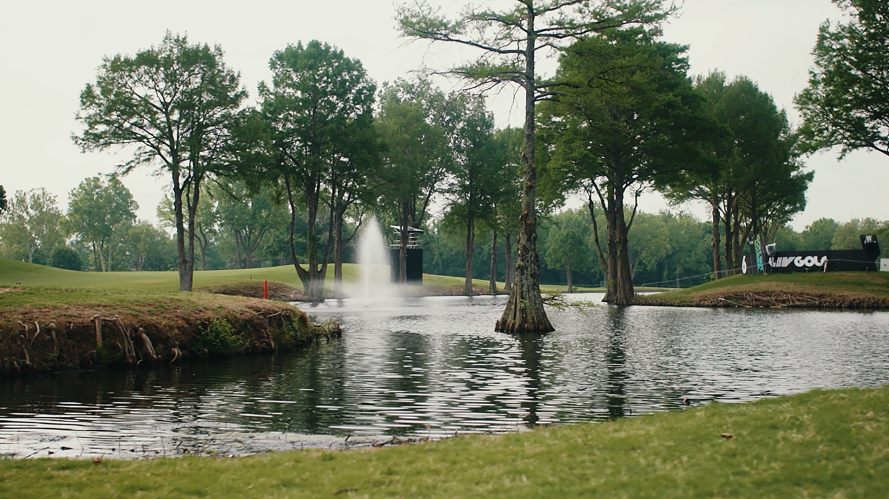CEDAR RIDGE READY DESPITE CHALLENGING CONDITIONS FOLLOWING DIFFICULT WINTER

BROKEN ARROW, Okla. – An early artic blast followed by longer-than-usual spring conditions led to a worst-case winterkill scenario for Cedar Ridge Country Club and other golf courses in the region.
But LIV Golf Tulsa tournament officials and the club’s agronomy staff have made the necessary adjustments to ensure this week’s competition will not be compromised.
While some areas of the par-70 layout – particularly the recently replaced collars around the greens – may not be aesthetically pleasing, LIV Golf consulting agronomist Matt Cielen remains confident the 48 players in the field will receive a fair and proper test, starting with Friday’s opening round.
“Several golf courses in the region have suffered some sort of damage. Some fortunate to have less, and some with significantly more than Cedar Ridge,” Cielen said. “We’ve tried to deal with the situations the best way we can based on our timeline of the tournament being played in May.”
Various parts of the 200-acre course suffered damage, including some high-visibility and high-usage areas. Landing areas in some fairways were affected, forcing officials to utilize different tee boxes to avoid those zones and provide stable second-shot conditions.
One such example is the 17th. The original plan was to utilize the forward tees for two rounds, making it a drivable par 4 at about 310 yards, with one round at the scorecard length of 443 yards. But due to damage in the landing area for the back tee, the hole will now utilize the forward tee for all three rounds.
“No. 17 would normally be played as a driver and probably a short- to mid-iron into the green,” Cielen said. “Playing from the forward tee, it will now be a very entertaining drivable par 4 or a layup and sand wedge in. That takes out one of the first fairways in that landing area, which would’ve been a potential stability problem and playability problem.”
The course adjustments and accelerated agronomy work leading up to the tournament were necessitated by a weather situation that began last fall.
Extended warm conditions prevented the Bermudagrass at Cedar Ridge from preparing for the winter months through its normal hardening-off process. That left parts of the course vulnerable when cold temperatures arrived quickly in December.
“It caught the plant off guard,” Cielen said.
Left vulnerable were high moisture areas, areas that faced in a northern direction, and shaded areas. Add in the usual amount of player traffic and rain events, and the Bermudagrass at Cedar Ridge was left at risk.
Timing was also an issue. With the course entering the point of dormancy, problem areas could not be detected immediately. “Everything looks consistently the same,” Cielen said. “You can’t tell where the injuries occurred.”
Only when the Bermudagrass came out of dormancy could course officials see which areas suffered winterkill.
“In this case, we had some areas that just did not come out of dormancy,” Cielen said. “At that point, the club had to react and make a decision on what needed to be handled and what didn’t.”
Six weeks ago, the decision was made to replace collars around all greens. Unfortunately, no local sod supplier could provide grass mown at the desired height or cut. So, Cedar Ridge took the best available sod, forcing significant prep work to reach the appropriate height.
“When you go through that process, it causes the grass plant to go almost into a shock because it’s not expecting to have such a drastic haircut,” Cielen said.
Additional topdressing and fertilizing applications have been applied in hopes of promoting growth, but with such a short transition window prior to tournament week, full growth has yet to be achieved.
“It's in the process now of becoming acclimated to its new expectations, and while it doesn't look as good now as it will by summertime, it's firm and it's playable. It'll take a little bit of time to live up to the standards and expectations of collars,” Cielen said.
“Installation of the local sod source gave us an opportunity to get something there that was living, supportive and firm that could be played on. In an ideal situation, we would have had sod that was mowed at a little lower height of cut to match up what we were doing. It just wasn't available to do.”
As for the fairway issues, the most noticeable parts will be along edges of the bunker, with a color contrast between the green grass and the sand. Due to the dormancy, the edges were reduced to dirt in some areas.
In hopes of achieving a presentable color, areas were spiked and seeded in hopes of germination. A painting technique was also tried in some areas, but with the usual course management of mowing and caretaking still scheduled, it was difficult to maintain the look.
The winterkill also impacted the tee decks on par-3 holes 4, 11 and 15. With rain in the forecast this week, officials feared the grass would become too slick, so the sod was replaced less than two weeks ago.
“Believe it or not, they have healed in beautifully,” Cielen said. “Those tee decks are going to be great. They’re in excellent shape.”
Cielen gives credit to Cedar Ridge course superintendent Eddie Roach and his staff for managing the challenging situation, identifying the issues as quickly as possible, and getting the course to a level of playability worthy of the world-class LIV Golf field.
“I’ve seen winterkill before, but I don’t think that I’ve seen winterkill of this magnitude,” Cielen said. “Had this event been scheduled for September, these conversations wouldn’t be happening. Everything would’ve been healed in, and no one would’ve ever known what happened in the winter of 2022.
“There were a lot of good decisions that were made in a timely manner in order to put us in the position where we’re playable for the tournament.”
MORE FROM TULSA: Gooch the ambassador | Groupings | Power rankings


